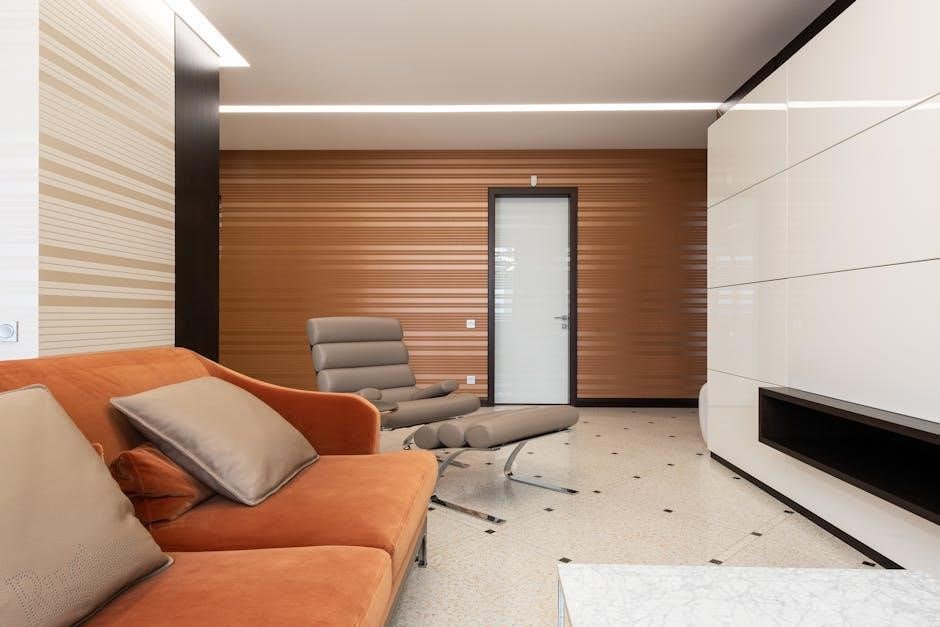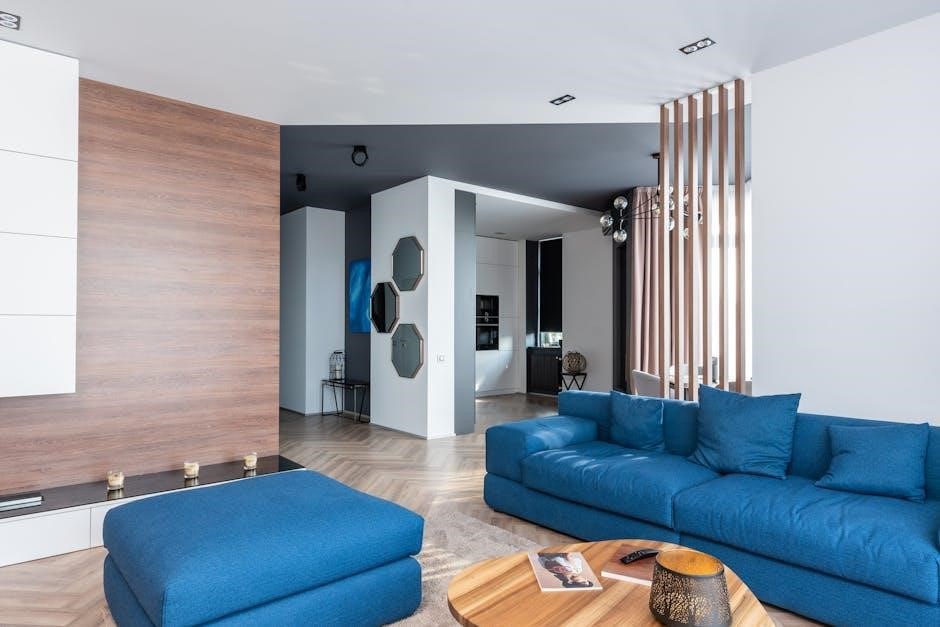The Carrier Comfort Zone 2 Manual is a comprehensive guide for installing, operating, and maintaining the Comfort Zone II zoning system, designed for residential HVAC control.
1.1 Purpose and Scope of the Manual
The purpose of the Carrier Comfort Zone 2 Manual is to provide a detailed guide for installers, technicians, and homeowners to understand and effectively use the Comfort Zone II zoning system. This manual covers the installation, operation, and maintenance of the system, ensuring optimal performance and energy efficiency. It includes step-by-step instructions for setting up the zoning controls, configuring smart sensors, and troubleshooting common issues. The scope extends to explaining the system’s compatibility with various HVAC equipment and its ability to manage up to 8 zones. Additionally, it emphasizes safety precautions and best practices for maintaining the system’s longevity. By following this manual, users can maximize the Comfort Zone II’s capabilities and enjoy a personalized heating and cooling experience.
1.2 Overview of the Comfort Zone 2 System
The Comfort Zone 2 System is a state-of-the-art zoning solution designed to enhance HVAC efficiency and comfort in residential settings. It allows precise temperature control across multiple zones, optimizing energy use and ensuring consistent comfort. With the ability to manage up to 8 distinct zones, the system offers flexibility for various home layouts. Advanced features like smart sensor integration and compatibility with a range of HVAC equipment further enhance its performance. The system is user-friendly, enabling seamless control through advanced thermostats and smart home integrations. Designed for reliability and durability, the Comfort Zone 2 System is a comprehensive solution for modern heating and cooling needs, ensuring personalized comfort and energy savings.
Key Features of the Carrier Comfort Zone 2 System
The Carrier Comfort Zone 2 System offers advanced zoning capabilities, smart sensor integration, and compatibility with various HVAC equipment, ensuring efficient and customized climate control solutions.
2.1 Zoning Capabilities (2, 4, or 8 Zones)
The Comfort Zone II system supports up to 8 distinct zones, allowing precise temperature control in different areas of a home or building. This flexibility ensures that each zone can be independently regulated, optimizing comfort and energy efficiency. Whether it’s a small residence with 2 zones or a larger space requiring 8, the system adapts seamlessly. By managing multiple zones, homeowners can avoid heating or cooling unoccupied areas, reducing energy waste. The zoning capabilities are customizable, enabling users to tailor their system to their specific needs, ensuring consistent comfort across all zones while minimizing operational costs.
2.2 Compatibility with HVAC Equipment
The Comfort Zone II system is designed to work seamlessly with a wide range of HVAC equipment, ensuring compatibility and optimal performance. It supports two-stage cooling and heating systems, allowing for precise temperature control and energy efficiency. The system can integrate with various HVAC units, including air conditioners, heat pumps, and furnaces, making it versatile for different home configurations. Carrier’s zoning system is engineered to adapt to the specific requirements of the installed equipment, ensuring consistent comfort across all zones. This compatibility minimizes installation challenges and maximizes the system’s potential to deliver reliable and efficient heating and cooling solutions for any home or business setup.

2.3 Smart Sensor Integration
Smart Sensors enhance the Comfort Zone II system by providing advanced temperature and humidity monitoring across multiple zones. These sensors can be installed in various areas to ensure precise control and comfort. They offer real-time data, allowing the system to adjust settings dynamically based on conditions in each zone. Smart Sensors are optional replacements for traditional remote sensors, offering enhanced functionality and integration with the Comfort Zone II interface. This feature enables users to monitor and adjust settings remotely, optimizing energy efficiency and system performance. The sensors are easy to install and configure, making them a valuable addition to the zoning system for improved comfort and control.

Installation Guidelines
The manual provides essential instructions for proper installation, including pre-installation checks, step-by-step guides, and safety considerations to ensure a smooth setup process for the Comfort Zone II system.
3.1 Pre-Installation Requirements
Before installing the Comfort Zone II system, ensure compatibility with existing HVAC equipment and verify the number of zones needed. Check for necessary tools and materials, and review safety guidelines to avoid hazards. Ensure proper space allocation for components like dampers and sensors. Review the manual thoroughly to understand technical specifications and wiring requirements. Plan the layout to minimize noise and ensure optimal airflow. Ensure all power sources are turned off during installation. Familiarize yourself with local building codes and regulations. Gather all necessary documentation and ensure all parts are included in the kit. Prepare the area to avoid damage to surrounding structures or equipment.
3.2 Step-by-Step Installation Instructions
Begin by mounting the zone dampers in the ductwork, ensuring proper sealing to prevent air leakage. Connect the wiring according to the diagram in the manual, paying attention to color coding for correct functionality. Install the Smart Sensors in each zone, positioning them away from direct sunlight and heat sources. Configure the control panel by setting the number of zones and syncing sensors with the system. Test each zone to ensure dampers open and close correctly. Check for proper airflow and adjust dampers as needed. Finally, power up the system and verify all components are functioning together seamlessly. Follow these steps carefully to ensure a smooth and efficient installation.

Operating the Comfort Zone 2 System
The Comfort Zone 2 System offers intuitive controls and smart sensor integration for precise temperature management across multiple zones, enhancing energy efficiency and home comfort effectively.
4.1 Basic Operation and Controls
The Comfort Zone 2 System operates through a user-friendly interface, allowing homeowners to regulate temperatures in up to 8 zones independently. The system utilizes smart sensors to monitor and adjust conditions, ensuring optimal comfort; The thermostat serves as the primary control, enabling users to set temperatures, view zone status, and adjust settings. Basic operation involves selecting zones, setting desired temperatures, and allowing the system to balance heating and cooling. The interface provides real-time feedback, making it easy to manage energy usage. Proper installation and setup are crucial for seamless operation. By following the manual’s guidelines, users can ensure efficient and effective control of their home’s climate, tailored to their specific needs.
4.2 Advanced Features and Settings
The Comfort Zone 2 System offers advanced features for enhanced customization and efficiency. Users can program custom schedules, adjusting temperatures for different zones at specific times. The system supports humidity control, ensuring optimal indoor air quality. Smart sensor integration allows for precise temperature monitoring and automatic adjustments. Advanced settings include multi-stage heating and cooling, enabling compatibility with high-efficiency HVAC equipment. The system also provides energy usage reports, helping homeowners optimize their energy consumption. Additionally, the Comfort Zone 2 System can be integrated with smart home devices for voice control and remote access. These features empower users to create a personalized and energy-efficient indoor climate, tailored to their lifestyle and preferences.
4.3 Troubleshooting Common Issues
Troubleshooting the Comfort Zone 2 System involves addressing common issues like uneven temperatures, noise, or connectivity problems. Check for proper damper installation and ensure vibration isolators are used to minimize noise. Verify that smart sensors are calibrated and placed correctly for accurate temperature readings. If zones are not responding, inspect wiring connections and ensure the system is powered on. For connectivity issues with smart devices, restart the system and ensure stable internet connection. Refer to the manual for detailed diagnostic steps and reset procedures. Regular maintenance, such as cleaning sensors and updating software, can prevent many issues. Addressing these problems promptly ensures optimal system performance and comfort.

Maintenance and Upkeep
Regular maintenance ensures optimal performance. Clean sensors, inspect dampers, and update software. Lubricate moving parts annually. Address issues promptly to maintain efficiency and comfort.
5.1 Routine Maintenance Tasks
Regular maintenance is crucial for the Comfort Zone II system’s efficiency. Clean or replace air filters quarterly and inspect ductwork for leaks. Check dampers for proper operation and lubricate moving parts annually. Ensure all sensors are free from dust and debris for accurate temperature readings. Update system software periodically to benefit from the latest features and improvements. Inspect wiring connections to prevent electrical issues. Address any unusual noises promptly to avoid component damage. Schedule professional servicing every two years to maintain optimal performance and extend system lifespan. These tasks ensure consistent comfort and energy efficiency.
5.2 Optimizing System Performance
To optimize the Comfort Zone II system’s performance, ensure proper airflow balance across all zones. Adjust temperature differentials to maintain consistent comfort levels. Utilize smart sensors for real-time monitoring and precise temperature control. Regularly update system software to access advanced features and improvements. Ensure ductwork is well-insulated and free from leaks to maximize efficiency. Balance airflow dampers to distribute heating and cooling evenly; Consider professional calibration for optimal performance. These steps enhance energy efficiency, reduce operational costs, and extend system lifespan, ensuring reliable and consistent comfort across all zones.
Integration with Smart Home Systems

The Comfort Zone 2 system seamlessly integrates with smart home devices, enabling voice control and remote monitoring via compatible thermostats and smart sensors for enhanced convenience and efficiency.
6.1 Compatible Smart Devices and Thermostats
The Carrier Comfort Zone 2 system is compatible with a range of smart devices and thermostats, including Amazon Alexa and Google Nest. Smart sensors can replace traditional remote sensors, allowing users to monitor and adjust settings remotely. The system supports voice control through smart speakers, enhancing convenience. Additionally, it integrates seamlessly with Carrier’s own smart thermostats, offering advanced features like geofencing and energy usage tracking. Compatibility ensures a unified smart home experience, enabling precise temperature control and energy efficiency. Always check the compatibility list for specific models to ensure seamless integration with your existing smart home setup. Proper configuration and firmware updates are essential for optimal performance.

6.2 Setup and Configuration Instructions
To set up the Comfort Zone 2 system with smart home devices, begin by connecting the system to your Wi-Fi network using the Carrier app. Ensure your thermostat and smart devices are compatible and updated with the latest firmware. Follow the app’s step-by-step guide to link your devices, enabling features like remote temperature control and scheduling. Install smart sensors in each zone to ensure accurate temperature readings. Configure zoning preferences and custom scenes for personalized comfort. Refer to the manual for specific wiring and connectivity requirements. Once configured, test the system to ensure seamless communication between components. Regularly update firmware for optimal performance and security. Proper setup ensures a fully integrated and efficient smart home experience.
